成功从来没有捷径。如果你只关注CVE/NVD的动态以及google专家泄露的POC,那你只是一个脚本小子。能够自己写有效POC,那就证明你已经是一名安全专家了。今天我需要复习一下glibc中内存的相关知识,以巩固我对堆溢出的理解和分析。带着以下问题去阅读本章:
我们以glibc为例探讨堆的运行机制,主要是因为服务器绝大部分都和glibc有关,研究glibc有广泛意义。
系统调用:malloc本身需要调用brk或mmap完成内存分配操作
线程:ptmalloc2的前身是dlmalloc,它们最大的区别是ptmalloc2支持线程,它提升了内存分配的效率。在dlmalloc中,如果有2个线程同时调用 malloc,只有一个线程可以进入关键区,线程之间共享同一个freelist数据结构。在ptmaloc2中,每一个线程都拥有单独的堆区段,也就意味着每个线程都有自己的freelist结构体。没有线程之间的共享和争用,性能自然提高不少。Per thread arena用来特指为每个线程维护独立的堆区段和freelist结构体的方式。
1 /* Per thread arena example. */ 2 #include <stdio.h> 3 #include <stdlib.h> 4 #include <pthread.h> 5 #include <unistd.h> 6 #include <sys/types.h> 7 8 void* threadFunc(void* arg) { 9 printf("Before malloc in thread 1\n"); 10 getchar(); 11 char* addr = (char*) malloc(1000); 12 printf("After malloc and before free in thread 1\n"); 13 getchar(); 14 free(addr); 15 printf("After free in thread 1\n"); 16 getchar(); 17 } 18 19 int main() { 20 pthread_t t1; 21 void* s; 22 int ret; 23 char* addr; 24 25 printf("Welcome to per thread arena example::%d\n",getpid()); 26 printf("Before malloc in main thread\n"); 27 getchar(); 28 addr = (char*) malloc(1000); 29 printf("After malloc and before free in main thread\n"); 30 getchar(); 31 free(addr); 32 printf("After free in main thread\n"); 33 getchar(); 34 ret = pthread_create(&t1, NULL, threadFunc, NULL); 35 if(ret) 36 { 37 printf("Thread creation error\n"); 38 return -1; 39 } 40 ret = pthread_join(t1, &s); 41 if(ret) 42 { 43 printf("Thread join error\n"); 44 return -1; 45 } 46 return 0; 47 }
分析:主线程在malloc调用之前,没有任何堆区和栈区被分配
sploitfun@sploitfun-VirtualBox:~/ptmalloc.ppt/mthread$ ./mthread Welcome to per thread arena example::6501 Before malloc in main thread ... sploitfun@sploitfun-VirtualBox:~/ptmalloc.ppt/mthread$ cat /proc/6501/maps 08048000-08049000 r-xp 00000000 08:01 539625 /home/sploitfun/ptmalloc.ppt/mthread/mthread 08049000-0804a000 r--p 00000000 08:01 539625 /home/sploitfun/ptmalloc.ppt/mthread/mthread 0804a000-0804b000 rw-p 00001000 08:01 539625 /home/sploitfun/ptmalloc.ppt/mthread/mthread b7e05000-b7e07000 rw-p 00000000 00:00 0 ... sploitfun@sploitfun-VirtualBox:~/ptmalloc.ppt/mthread$
主线程在调用malloc之后,从下图中我们可以看出堆区域被分配在0804b000-0806c000区域,这是通过调用brk调整内存中止点来建立堆。此外,尽管申请了1000字节,但分配了132KB的堆内存。这个连续区域被称为Arena。主线程建立的就称为Main Arena。未来分配内存的请求会持续使用Arena区域直到用尽。如果用尽,可以调整内存中止点来扩大Top trunk。相似的,也可以相应的收缩以防止top chunk有太多的空间。(Top trunk是Arena最顶部的chunk)
sploitfun@sploitfun-VirtualBox:~/ptmalloc.ppt/mthread$ ./mthread Welcome to per thread arena example::6501 Before malloc in main thread After malloc and before free in main thread ... sploitfun@sploitfun-VirtualBox:~/lsploits/hof/ptmalloc.ppt/mthread$ cat /proc/6501/maps 08048000-08049000 r-xp 00000000 08:01 539625 /home/sploitfun/ptmalloc.ppt/mthread/mthread 08049000-0804a000 r--p 00000000 08:01 539625 /home/sploitfun/ptmalloc.ppt/mthread/mthread 0804a000-0804b000 rw-p 00001000 08:01 539625 /home/sploitfun/ptmalloc.ppt/mthread/mthread 0804b000-0806c000 rw-p 00000000 00:00 0 [heap] b7e05000-b7e07000 rw-p 00000000 00:00 0 ... sploitfun@sploitfun-VirtualBox:~/ptmalloc.ppt/mthread$
主线程 Free之后,内存并未归还给OS,而是交由glibc malloc管理,放在Main Arena的bin中。(freelist数据结构体就是bin)之后所有的空间申请,都会在bin中寻求满足。无法满足时才再次向内核获得空间。
sploitfun@sploitfun-VirtualBox:~/ptmalloc.ppt/mthread$ ./mthread Welcome to per thread arena example::6501 Before malloc in main thread After malloc and before free in main thread After free in main thread ... sploitfun@sploitfun-VirtualBox:~/lsploits/hof/ptmalloc.ppt/mthread$ cat /proc/6501/maps 08048000-08049000 r-xp 00000000 08:01 539625 /home/sploitfun/ptmalloc.ppt/mthread/mthread 08049000-0804a000 r--p 00000000 08:01 539625 /home/sploitfun/ptmalloc.ppt/mthread/mthread 0804a000-0804b000 rw-p 00001000 08:01 539625 /home/sploitfun/ptmalloc.ppt/mthread/mthread 0804b000-0806c000 rw-p 00000000 00:00 0 [heap] b7e05000-b7e07000 rw-p 00000000 00:00 0 ... sploitfun@sploitfun-VirtualBox:~/ptmalloc.ppt/mthread$
在调用thread1中malloc之前,thread1的堆区域并未建立,但线程栈已建立。
sploitfun@sploitfun-VirtualBox:~/ptmalloc.ppt/mthread$ ./mthread Welcome to per thread arena example::6501 Before malloc in main thread After malloc and before free in main thread After free in main thread Before malloc in thread 1 ... sploitfun@sploitfun-VirtualBox:~/ptmalloc.ppt/mthread$ cat /proc/6501/maps 08048000-08049000 r-xp 00000000 08:01 539625 /home/sploitfun/ptmalloc.ppt/mthread/mthread 08049000-0804a000 r--p 00000000 08:01 539625 /home/sploitfun/ptmalloc.ppt/mthread/mthread 0804a000-0804b000 rw-p 00001000 08:01 539625 /home/sploitfun/ptmalloc.ppt/mthread/mthread 0804b000-0806c000 rw-p 00000000 00:00 0 [heap] b7604000-b7605000 ---p 00000000 00:00 0 b7605000-b7e07000 rw-p 00000000 00:00 0 [stack:6594] ... sploitfun@sploitfun-VirtualBox:~/ptmalloc.ppt/mthread$
在thread1中malloc调用之后,线程堆区段建立了。位于b7500000-b7521000,大小132KB。这显示和主线程不同,线程malloc调用的是mmap系统调用,而非sbrk。尽管用户请求1000字节,1M的堆内存被映射到了进程地址空间。但只有132KB被设置为可读写权限,并被设置为该线程的堆空间。这个连续的内存空间是Thread Arena。
当用户内存请求大小超过128KB时,不论请求是从主线程还是子线程,内存分配都是由mmap系统调用来完成的。
sploitfun@sploitfun-VirtualBox:~/ptmalloc.ppt/mthread$ ./mthread Welcome to per thread arena example::6501 Before malloc in main thread After malloc and before free in main thread After free in main thread Before malloc in thread 1 After malloc and before free in thread 1 ... sploitfun@sploitfun-VirtualBox:~/ptmalloc.ppt/mthread$ cat /proc/6501/maps 08048000-08049000 r-xp 00000000 08:01 539625 /home/sploitfun/ptmalloc.ppt/mthread/mthread 08049000-0804a000 r--p 00000000 08:01 539625 /home/sploitfun/ptmalloc.ppt/mthread/mthread 0804a000-0804b000 rw-p 00001000 08:01 539625 /home/sploitfun/ptmalloc.ppt/mthread/mthread 0804b000-0806c000 rw-p 00000000 00:00 0 [heap] b7500000-b7521000 rw-p 00000000 00:00 0 b7521000-b7600000 ---p 00000000 00:00 0 b7604000-b7605000 ---p 00000000 00:00 0 b7605000-b7e07000 rw-p 00000000 00:00 0 [stack:6594] ... sploitfun@sploitfun-VirtualBox:~/ptmalloc.ppt/mthread$
Thread1在free之后,被分配的内存区并未交还给操作系统,而是归还给glicbc分配器,实际上它交给了线程Arena bin.
sploitfun@sploitfun-VirtualBox:~/ptmalloc.ppt/mthread$ ./mthread Welcome to per thread arena example::6501 Before malloc in main thread After malloc and before free in main thread After free in main thread Before malloc in thread 1 After malloc and before free in thread 1 After free in thread 1 ... sploitfun@sploitfun-VirtualBox:~/ptmalloc.ppt/mthread$ cat /proc/6501/maps 08048000-08049000 r-xp 00000000 08:01 539625 /home/sploitfun/ptmalloc.ppt/mthread/mthread 08049000-0804a000 r--p 00000000 08:01 539625 /home/sploitfun/ptmalloc.ppt/mthread/mthread 0804a000-0804b000 rw-p 00001000 08:01 539625 /home/sploitfun/ptmalloc.ppt/mthread/mthread 0804b000-0806c000 rw-p 00000000 00:00 0 [heap] b7500000-b7521000 rw-p 00000000 00:00 0 b7521000-b7600000 ---p 00000000 00:00 0 b7604000-b7605000 ---p 00000000 00:00 0 b7605000-b7e07000 rw-p 00000000 00:00 0 [stack:6594] ... sploitfun@sploitfun-VirtualBox:~/ptmalloc.ppt/mthread$
Arena:
在上面的例子中,主线程对应的是Main Arena,子线程对应的是Thread Arena。那线程和Arena是否是一一对应的呢?不是。实际上线程数可以多于核数,因此,让一个线程拥有一个Arena有些奢侈。应用程序Arena的数量是和核数相关的,具体如下:
For 32 bit systems: Number of arena = 2 * number of cores. For 64 bit systems: Number of arena = 8 * number of cores.
Multiple Arena:
举例说明:一个单核32位系统有4个线程(1主3子)。那4个线程只有2个Arena。Glibc内存分配器确保Multiple Arena在线程之间共享
多堆:
Heap_info: 堆头。一个线程Arena拥有多个堆,每个堆有它自己的头。之所以有多个堆,是因为开始的时候只有一个堆,但随着堆区空间用尽,新堆会由mmap重新建立,而且地址空间是不连续的,新旧堆无法合并
malloc_state: Arena Header - 一个线程Arena有多个堆,但那些堆只有一个Arena头。Arena头包含了bins,top chunk和last remainder chunk等信息
malloc_chunk: Chunk Header - 一个堆被分为很多chunks,多个用户请求导致多个chunk。每个chunk有它自己的头部信息
注意:


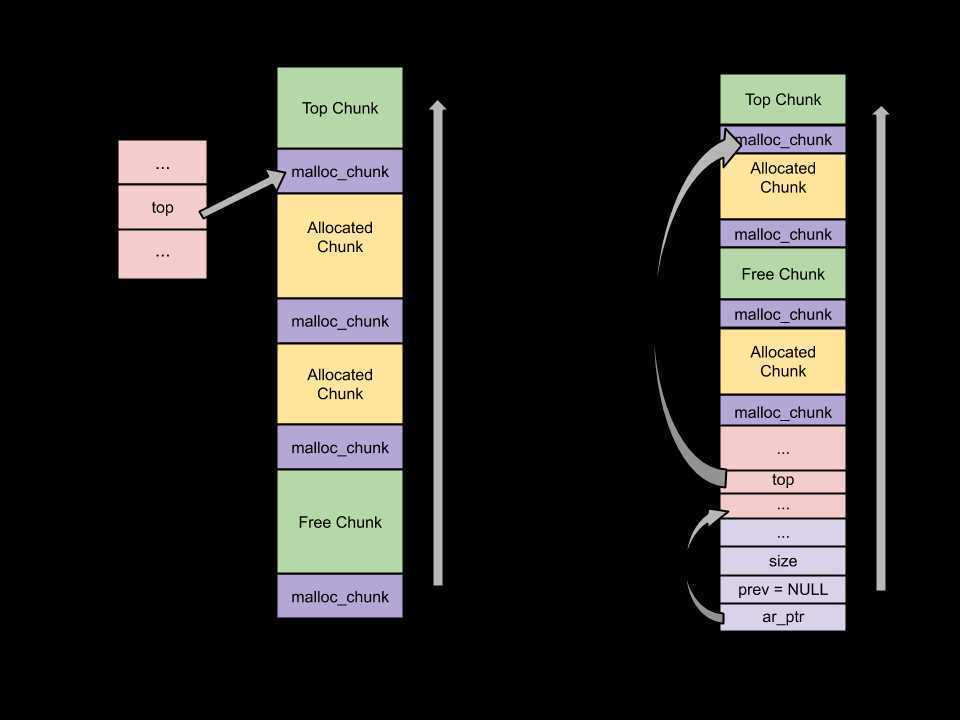
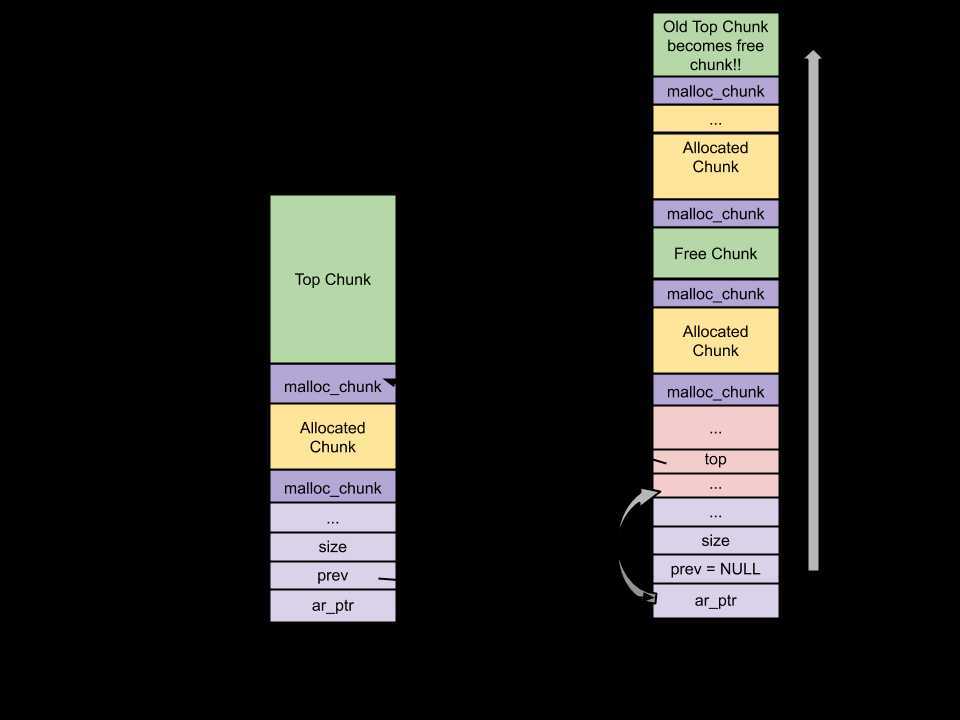
Chunk的类型:
Allocated Trunk:
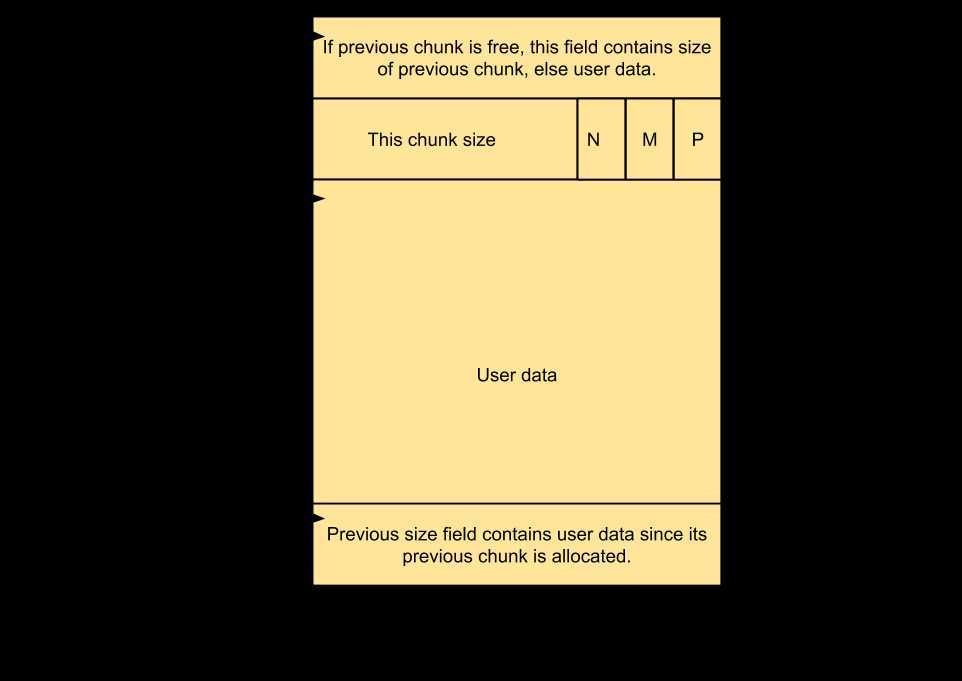
prev_size: 前一个chunk为空闲区,则该区域包含前一区域的大小。如果非空闲,则该域包含前一区域的用户数据
size: 被分配空间的大小 。后三比特域包含标志位
注意:
Free Trunk:
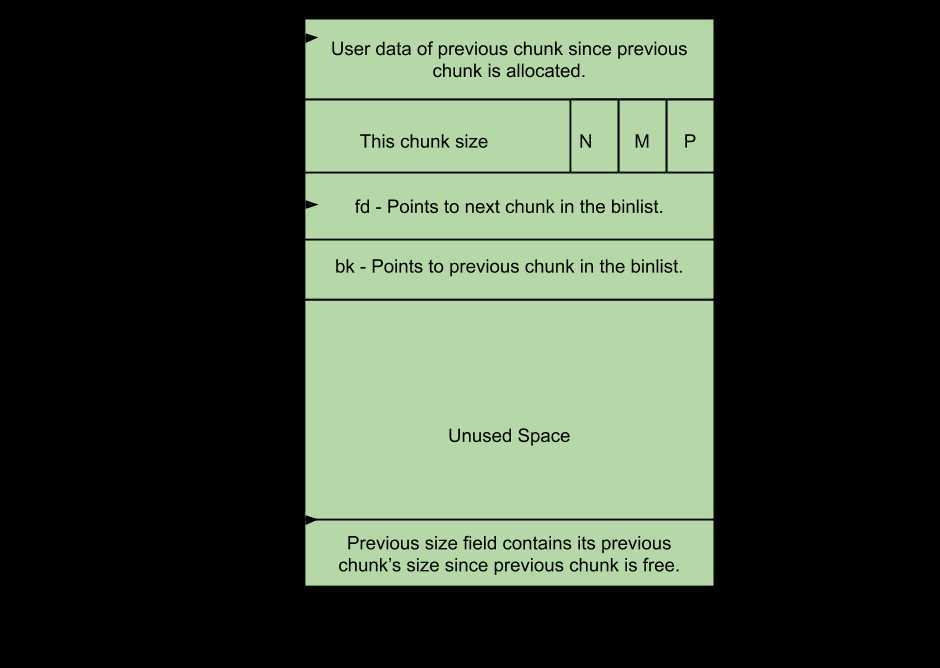
prev_size: 两个空闲区不能毗邻,当两个chunk空闲豕毗邻,则会合并为一个空闲区。因此通常前一个chunk是非空闲的,prev_size是前一个chunk的用户数据
size: 空间大小
fd: Forward pointer – 同一bin中的下一个chunk(非物理空间)
bk: Backward pointer – 同一bin中的前一个chunk(非物理空间)
Bins: 根据大小不同,有如下bin
fastbinsY: 这个array是fastbin列表
bins: 共有126 个bins
Fast Bin: 大小在16~80字节之间.
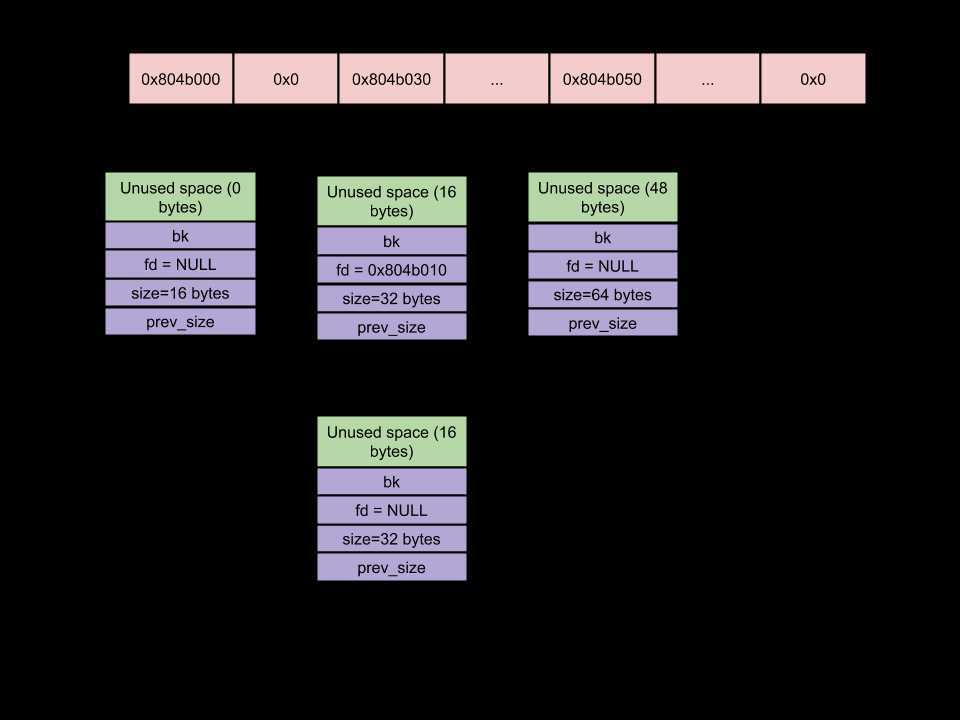
Unsorted Bin: 当small chunk 或 large chunk被释放,不是将其归还给相应的bin中,而是添加至unsorted bin。这对性能有所提升
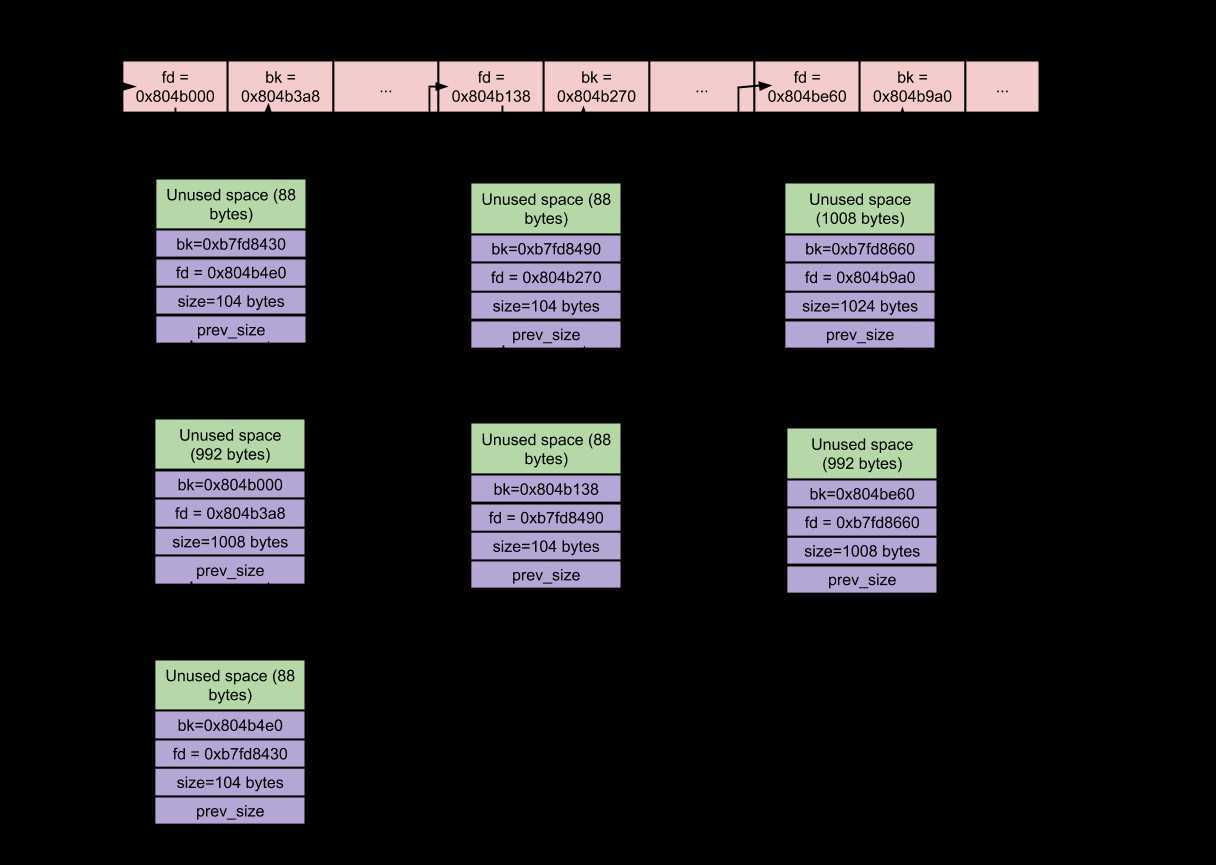
Small Bin:大小小于512字节的块称为小块。small bins在内存分配和释放方面比large bins快(但比fast bins慢)。
Large Bin:大小大于512的块称为大块。存放大块的垃圾箱称为大垃圾箱。大存储区在内存分配和释放方面比小存储区慢。
垃圾箱数量– 63
每个大垃圾箱都包含一个循环的空闲块的双向链接列表(又称垃圾箱)。使用双链表是因为在大仓中,可以在任何位置(前,中或后)添加和删除块。
在这63个垃圾箱中:
32个bin包含大小为64个字节的块的binlist。即)第一个大容器(Bin 65)包含大小为512字节至568字节的块的binlist,第二个大容器(Bin 66)包含大小为576字节至632字节的块的binlist,依此类推…
16个bin包含大小为512字节的块的binlist。
8个bin包含大小为4096字节的块的binlist。
4个bin包含大小为32768字节的块的binlist。
2个bin包含大小为262144个字节的块的binlist。
1箱包含一块剩余的大小。
与小垃圾箱不同,大垃圾箱中的块大小不相同。因此,它们以降序存储。最大的块存储在前端,而最小的块存储在其binlist的后端。
合并–两个空闲的块不能彼此相邻,将它们合并为一个空闲的块。
malloc(大块)–
最初,所有大容器都将为NULL,因此即使用户请求了大块而不是大容器代码,下一个最大的容器代码也会尝试为其服务。
同样在第一次调用malloc的过程中,将初始化malloc_state中发现的小bin和大bin数据结构(bin),即,bin指向自身,表示它们为空。
稍后,当大容器为非空时,如果最大的块大小(在其Binlist中)大于用户请求的大小,则将Binlist从后端移动到前端,以找到大小接近/等于用户请求的大小的合适块。一旦找到,该块将分为两个块
用户块(具有用户请求的大小)–返回给用户。
剩余块(剩余大小)–添加到未排序的垃圾箱。
如果最大的块大小(在其binlist中)小于用户请求的大小,请尝试使用下一个最大的(非空)容器来满足用户请求。下一个最大的bin代码扫描binmap,以查找不为空的下一个最大的bin,如果找到任何这样的bin,则从该binlist中检索合适的块并将其拆分并返回给用户。如果找不到,请尝试使用顶部块满足用户请求。
free(大块)–其过程类似于free(小块)
TOP Chunk: Arena顶部的chunk称为top chunk. 它不属于任何bin。它在当用户需求无法满足时使用。如果top chunk size 比用户请求大小大,那top chunk被分为两个
剩下的块成为新的top chunk。如果top chunk 大小小于用户请求大小,则top chunk调用sbrk(Main arena)或mmap(thread arena)系统调用进行延展
Last Remainder Chunk: 即最近一次切割后剩下的那个chunk. Last remainder chunk 可帮助提升性能。连续的small chunk请求可能会导致分配的位置相近。
在很多arena的chunk中,哪个能够成为last reminder chunk?
当一个用户请求small chunk,small bin和unsorted bin都无法满足,就会扫描binmaps进而找寻next largest bin. 正如较早提及的,找到the next largest bin,它将会分为2个chunk,user chunk返回给用户,remainder chunk 添加至unsorted bin. 除此之外,它成为最新的last remainder chunk.
原文:https://www.cnblogs.com/uncontrolledbits/p/12776436.html